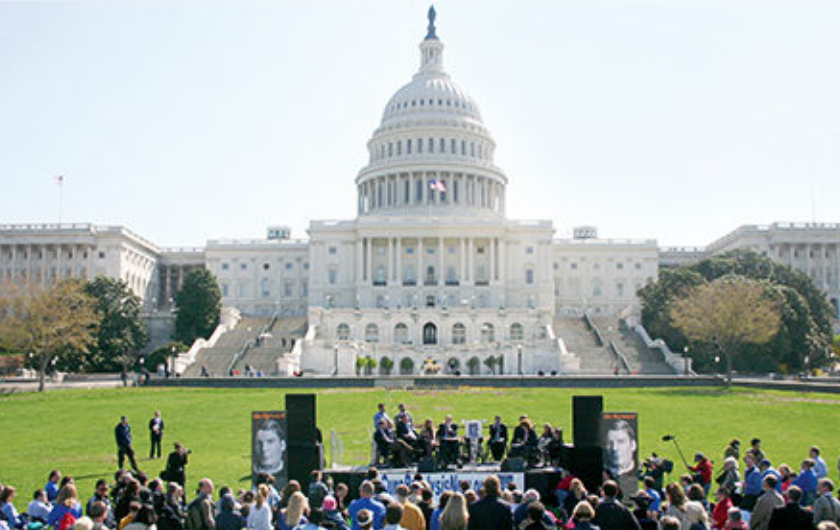Human Rights Includes Disability Rights
Some people say that what I did changed the world, but really, I simply refused to accept what I was told about who I could be. And I was willing to make a fuss about it. -- Judy Heumann, 1947-2023

December 10, 2024 — Human Rights Day — is the 76th anniversary of the Universal Declaration of Human Rights, proclaimed at a time when our global civilization was recovering from World War II, the deadliest war in history. Meeting in Paris on December 10, 1948, the General Assembly of the United Nations — representatives from all parts of the world — drafted a document that has been translated into more than 500 languages. Its purpose was to eliminate “disregard and contempt for human rights [that] have resulted in barbarous acts which have outraged the conscience of mankind…” Broadly stated, the UCHD seeks to recognize, promote and protect the inherent dignity, freedom and inalienable rights of all people in all nations.
In its early years, the UCHD focused on restoring lives of refugees, survivors of genocide and persecuted people, with 30 separate Articles ranging from the right to live free of slavery and persecution, to freedom of religion, movement and thought. Since then its mission has broadened to include, among other groups, people with disabilities. But inclusion of the disability community has not come easily.
In the first half of the 1900’s, disabled people were pitied, considered to be deserving of charity only. A major step forward came when Franklin D. Roosevelt, paralyzed from polio in 1921, claimed beneficial effects from swimming often in Warm Springs, Georgia. He bought the property and started a foundation to develop and support it as the first rehabilitation center. The concept of rehabilitation for people with paralysis, while not directly related to the Human Rights Movement, was an important milestone that led to polio survivors being able to return to active life. Roosevelt went on to become one of the most acclaimed Presidents in U.S. history. But the concept of disability rights had yet to be recognized.
Paralyzed Veterans of America, founded in 1946 by wartime survivors of spinal cord injury, made a giant leap toward recognition of their right to live freely by advocating for and receiving government-funded benefits such as health care, education, and home loans. The Civil Rights Act of 1964, while initially recognizing civil rights of black people, now includes people with disabilities, mainly involving issues covered by the separate but equal clause. The Architectural Barriers Act of 1968 helped remove some physical barriers in federal buildings, and the Vocational Rehabilitation Act of 1973, Section 504, expanded rights to include education, healthcare and other areas that receive federal funding.
But the 1973 Act languished for years, unsigned, not enforced, until advocates took organized action. In 1977, disability advocates forced the 1977 signing by occupying federal buildings throughout the United States, with national television coverage focusing on San Francisco’s Health, Education and Welfare building. In this legendary action, more than 100 disabled protestors slept in hallways, with sleeping bags, blankets, food, medicines and medical supplies delivered by fellow activists over nearly a month. This historic event was an unparalled bold demand by many courageous disabled individuals.
Judy Heumann, who had sued New York’s Public Education Department for the right to teach in 1971, was among the leaders of the 1977 protest. She went on to serve in government positions and national and international agencies in support of disability rights., Ed Roberts, founder of the “Rolling Quads” and later, a co-founder of the World Institute on Disability, was instrumental in pushing back barriers to higher education and independent living. Brad Lomax brought Oakland’s Black Panthers into the mix as providers of meals and supplies for the protest.
In 1981, the United Nation’s Human Rights Convention formally recognized people with disabilities as being entitled to full human rights.
In 1990 the United States Congress enacted the Americans with Disabilities Act, which expanded disability civil rights to include public life, has been used by nations throughout the world as a model for recognizing the civil rights of disabled citizens. Justin Dart, Jr. was an unstoppable force in getting the law enacted, visiting 50 states more than once in rounding up support for passage of the ADA. Thousands of disability activists have promoted and defended the ADA since then. Among them, Andrea Dalzell stands out for breaking through the healthcare employment barrier by becoming a wheelchair-using nurse and advocating for others.
We have literally thousands of everyday disability advocates to thank for gaining inclusion in the broader movement of human rights, including civil rights activists inspired by Martin Luther King, Jr.
Let us dedicate ourselves to doing all we can to promote dignity, freedom and respect for all people of all nations, regardless of our differences. After all, we belong — we are all members of the same family.
Join Our Movement
What started as an idea has become a national movement. With your support, we can influence policy and inspire lasting change.
Become an Advocate